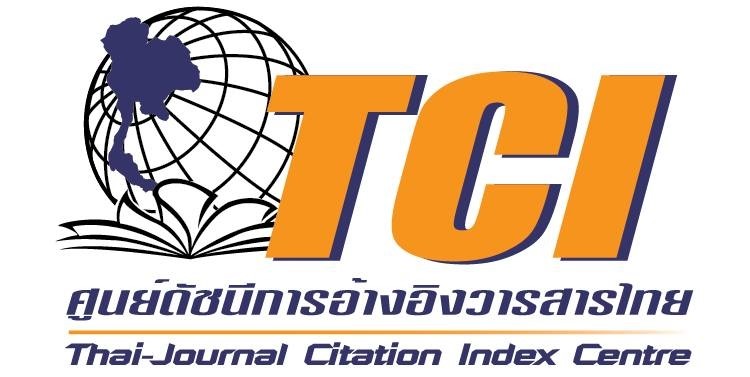การลงทุนตราสารอนุพันธ์ในตลาดสัญญาซื้อขายล่วงหน้าของประเทศไทย
คำสำคัญ:
การลงทุน, ตราสารอนุพันธ์, ตลาดสัญญาซื้อขายล่วงหน้าบทคัดย่อ
การวิจัยครั้งนี้มีวัตถุประสงค์เพื่อศึกษาปัจจัยการลงทุนด้านอายุสัญญาฟิวเจอร์สที่ส่งผลต่อความผันผวนราคาและศึกษาปัจจัยการลงทุนด้านปริมาณสัญญาการซื้อขายฟิวเจอร์สที่ส่งผลต่อความผันผวนราคา SET50 Index Futures ในตลาดตราสารอนุพันธ์ของประเทศไทย โดยใช้ข้อมูลทุติยภูมิที่ทำการเก็บรวบรวมข้อมูลจากโปรแกรม SETSMART ประกอบด้วย ดัชนีราคาปิดการซื้อขายเพื่อคำนวณหาอัตราผลตอบแทน ปัจจัยด้านปริมาณการซื้อขาย ปัจจัยด้านอายุสัญญาฟิวเจอร์ส ของ SET50 Index Futures ในตลาดตราสารอนุพันธ์ประเทศไทยระหว่างปี พ.ศ. 2561 – 2565 และทำการวิเคราะห์โดยใช้แบบจำลอง Generalized Autoregressive Conditional Heteroscedasticity (GARCH) พบว่า ปัจจัยการลงทุนด้านอายุสัญญาฟิวเจอร์สไม่ส่งผลต่อความผันผวนราคา SET50 Index Futures ในตลาดตราสารอนุพันธ์ของประเทศไทยระหว่างปี พ.ศ. 2561-2565 ที่ระดับความเชื่อมั่นร้อยละ 95 และปัจจัยการลงทุนด้านปริมาณสัญญาการซื้อขายฟิวเจอร์สไม่ส่งผลต่อความผันผวนราคา SET50 Index Futures ในตลาดตราสารอนุพันธ์ของประเทศไทยระหว่างปี พ.ศ. 2561-2565 ที่ระดับความเชื่อมั่นร้อยละ 95
References
บริษัท ตลาดสัญญาซื้อขายล่วงหน้า (ประเทศไทย) จำกัด (มหาชน). (2564). รายงานประจำปี. สืบค้น กุมภาพันธ์ 16, 2566 จาก https://media.tfex.co.th/tfex/Documents/2023/Nov/TFEXAnnualReport2564.pdf
บริษัท ตลาดสัญญาซื้อขายล่วงหน้า (ประเทศไทย) จำกัด (มหาชน). (2565). รายงานประจำปี. สืบค้น มีนาคม 2, 2566 เข้าถึงได้จาก https://media.tfex.co.th/tfex/Documents/2023/Nov/TFEXAnnualReport2565.pdf
พรอนงค์ บุษราตระกูล และรัฐชัย ศีลาเจริญ. (2563). อนุพันธ์ทางการเงิน : การประเมินราคาและการนำไปใช้ Financial derivatives: pricing and applying. กรุงเทพฯ: จินดาสาส์นการพิมพ์.
อาณัติ ลีมัคเดช. (2556) . หลักการลงทุนและป้องกันความเสี่ยงด้วยตราสารอนุพันธ์ทางการเงิน. กรุงเทพฯ: ตลาดหลักทรัพย์แห่งประเทศไทย.
Adams, E., & Runkle, D. (2000). The Easy Case for Derivatives Use: Advocating a Corporate Fiduciary Duty to Use Derivatives. William & Mary Law Review, 41(2), 595.
Afrina, T., Beg, T. H., Zayed, N. M., Hossain, M. S., & Shahi, S. K. (2020). An Analysis of the Effects of Corona Virus (COVID-19) on International Financial Derivatives Market, 2020.Indian Journal of Finance and Banking, 4(2), 93–98.
Ahmad, A. A., Mohd Dasar, M. H., & Nik Abdul Ghani, N. A. R. (2021). Analysis of Tawarruq contract in the Islamic profit rate swap (IPRS) implementation in Malaysia. Qualitative Research in Financial Markets, 14(3), 395–412.
Backstrand, K. (1997). Introduction to Derivative Instruments. Working Paper 9-295-141, Harvard Business School.
Bollerslev, T. (1986). Generalized autoregressive conditional heteroskedasticity. Journal of Econometrics, 52, 5–59.
Breusch, T., Pagan, A. (1979). A simple test for heteroskedasticity and random coefficient variation. Econometrica, 47, 1278-1294.
Copeland, T. E. (1976). A Model of Asset Trading Under the Assumption of Sequential Information Arrival. The Journal of Finance, 31(4), 1149–1168.
Enders, W. (1995). Applied Econometric Time Series: 2. Journal of the American Statistical Association, 90.
Engle, R. F., Lilien, D. M., & Robins, R. P. (1987). Estimating Time Varying Risk Premia in the Term Structure: The Arch-M Model. Econometrica, 55(2), 391–407.
George, D. & Mallery, M. (2010). SPSS for Windows step by step: A simple guide and reference 17.0 update. (10thed). Boston: Pearson.
Goldman, G. B. (1995). Crafting a Suitability Requirement for the Sale of Over-the-Counter Derivatives: Should Regulators Punish the Wall Street Hounds of Greed Notes. Columbia Law Review, 95(5), 1112–1159.
Hair, J. F. Jr., Black, W. C., Babin, B. J., Anderson, R. E., & Tatham, R. L. (2006). Multivariate data analysis. (6thed). New Jersey: Prentice Hall.
Hull, J.C. (2002). Options, Futures and Other Derivatives. 5th edition. Prentice Hall, New Jersey.
Lam, S.-S., Li, T., & Zhang, W. (2019). Unveil the economic impact of policy reversals: The China experience. China Finance Review International, 10(1), 16–36.
Samuelson, Paul A. 1965. Proof That Properly Anticipated Prices Fluctuate Randomly. Industrial Management Review, 6(2), 41-49.
Sharif, A., Aloui, C., & Yarovaya, L. (2020). COVID-19 pandemic, oil prices, stock market, geopolitical risk and policy uncertainty nexus in the US economy: Fresh evidence from the wavelet-based approach. International Review of Financial Analysis, 70, 101496.
Sharma, D., Ahalawat, S., Patro, A., & Kumar, P. (2021). Spot market and derivative segment of equity in India. Applied Economics, 54, 1–14.
Stevens, J. (1996). Applied Multivariate Statistics for the Social Science. Lawrence Erlbaum Associate, Inc., Mahwah, New Jersey.
White, H. (1980). A heteroskedasticity-consistent covariance matrix estimator and a direct test for heteroskedasticity. Econometrica, 48(4), 817-838.
Downloads
เผยแพร่แล้ว
How to Cite
ฉบับ
บท
License
Copyright (c) 2024 วารสารวิทยาการจัดการ มหาวิทยาลัยราชภัฏสกลนคร

This work is licensed under a Creative Commons Attribution-NonCommercial 4.0 International License.
บทความที่ตีพิมพ์ในวารสารวิทยาการจัดการ มหาวิทยาลัยราชภัฏสกลนคร เป็นทัศนะ ลิขสิทธิ์ และความรับผิดชอบของผู้เขียนเจ้าของผลงาน






